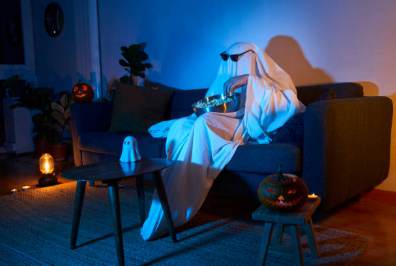!!SPOILER WARNING!!
Horror movies are designed to make us uncomfortable, but the best ones go further. They explore what it means to be human when faced with fear.
Films like Smile (2022), 28 Days Later (2002), The Silence of the Lambs (1991), and Nobody Sleeps in the Woods Tonight (2020) all tackle terror in different ways, using unique settings and psychological tension to unsettle their audiences.
Together, these films show that horror isn’t just about monsters or gore—it’s about the mind, survival, and the darkness that exists within people.
Parker Finn’s Smile is a modern psychological horror that turns trauma into a curse. The story follows Dr. Rose Cotter, a therapist who begins experiencing horrifying hallucinations after witnessing a patient’s suicide.
What makes Smile stand out is how it connects supernatural horror with mental health. The “curse” becomes a metaphor for untreated trauma, showing how fear and guilt can spread like an infection.
“I felt like Smile was more trickery to make you feel more suspense while you’re watching it,” Andrew Cleiman said.
The film’s lighting, sound design, and disturbing visuals build a constant sense of dread, even when nothing overtly scary is happening. What makes Smile truly frightening isn’t the monster itself; it’s the feeling that no matter how hard Rose tries to escape her past, it always finds her.
Where Smile internalizes fear, Danny Boyle’s 28 Days Later externalizes it through a world-ending viral outbreak.
The movie opens with haunting shots of an abandoned London, setting the tone for a story that mixes horror with social commentary. The infected in 28 Days Later aren’t slow-moving zombies, they’re fast. violent. and relentless. Yet, the real horror often comes from the surviving humans, who turn savage when order disappears.
Boyle’s use of shaky camera work and natural lighting makes the film feel raw and realistic, and Cillian Murphy’s performance as Jim adds a human layer to the post-apocalyptic nightmare.
The movie asks a chilling question, “when the world ends, who are the real monsters. the infected or us?”
In The Silence of the Lambs, Jonathan Demme crafts a thriller that blurs the line between horror and crime.
The film follows FBI trainee Clarice Starling as she seeks help from imprisoned serial killer Dr. Hannibal Lecter to catch another killer, Buffalo Bill.
Unlike most horror villains, Lecter isn’t terrifying because of what he does—he’s terrifying because of how calm, polite, and intelligent he is.
Anthony Hopkins’s performance captures the essence of psychological manipulation, while Jodie Foster’s portrayal of Clarice makes her both vulnerable and determined.
“I really liked how it kept you on your toes and I liked how Hannibal Lector, and when you first saw him, you felt this energy around him…and the fact the buffalo bill was based on a real character gave depth to the movie as a whole,” Aubrie Hodgkins, an LHS Senior said.
The movie’s tension doesn’t rely on jump scares or gore; it’s built through dialogue and silence. Every conversation between Clarice and Lecter feels like a chess match, where words are weapons.
The Silence of the Lambs proves that horror can be as much about intellect as it is about fear.
Finally, Nobody Sleeps in the Woods Tonight, a Polish slasher directed by Bartosz M. Kowalski, pays homage to classic horror while adding its own twist.
The story follows a group of teens at a “technology-free” camp who stumble upon a monstrous family living in the forest.
At first, it seems like a typical slasher film, complete with jump scares, isolated settings, and characters making bad decisions.
Though it’s not as polished or complex as the other films, its self-awareness and brutal practical effects give it a distinct charm. It’s both a parody and a celebration of the genre.
When viewed together, these four films illustrate different sides of horror: the psychological (Smile), the apocalyptic (28 Days Later), the intellectual (The Silence of the Lambs), and the traditional slasher (Nobody Sleeps in the Woods Tonight).
Each movie uses fear as a tool to explore human nature, how we cope, adapt, and sometimes lose ourselves in the face of terror.
Whether it’s a smile that hides trauma, a virus that destroys civilization, a killer who outsmarts his captors, or monsters lurking in the woods, these stories remind us that fear isn’t just on the screen. It lives within us.
